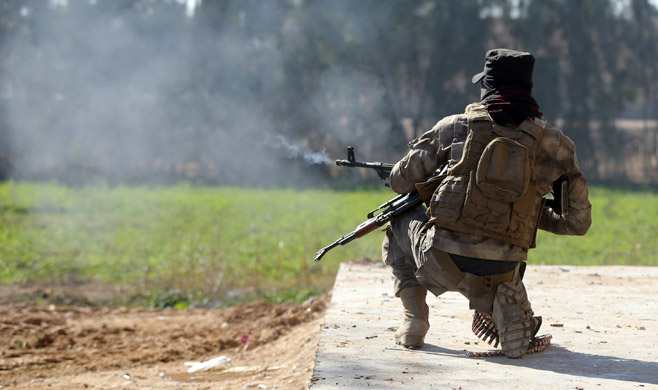
North Caucasus Militants Split Between Caucasus Emirate and Islamic State, as Radical Islam Gains Influence in Region
Publication: Eurasia Daily Monitor Volume: 12 Issue: 19
By:

In the run-up to the fifth anniversary of the founding the North Caucasus Federal District, Russia’s Ministry of Interior officially reported the results of 2014. It said the law enforcement agencies last year killed 259 members of the armed underground movement, including 36 leaders. In addition, 421 militants and their accomplices were arrested in 2014, while 24 members of illegal armed groups were forced to surrender. The head of the regional directorate of the Russian interior ministry, Sergei Chenchik, stated that the armed underground movement’s activities, including bomb attacks and shootings, declined in the North Caucasus Federal District in 2014. “In the reporting period, the police and security forces carried out a number of successful special operations and special actions to identify and neutralize the leaders and active members of gangs operating in the area, detect and suppress their supporters and disrupt their resource base channels,” Chenchik said (Skfo.mvd.ru, January 26).
The death toll among both the civilians and the militants declined in 2014. To understand the development of the situation in the region it is important to see that plummeting activities of the rebels were matched by lower activities of the law enforcement agencies. The figures indicate that the conflict is transitioning from a military phase to that of a political phase. The ideology of militant Islam is infiltrating all layers of the society. This is no longer the ideology of poor and uneducated people. Today, radical Islam is part of the discourse of the local intelligentsia. Of course, an intellectual is not prepared to go underground and fight, but he is already quite critical of the Russian state system, and this poses a problem for Russia. This transition is more dangerous for Moscow than an open conflict with several hundred radical militants.
Structural changes in the leadership of the North Caucasus armed resistance movement are also worth noting. The death of long-time militant leader Doku Umarov resulted in a shift of the political center of the resistance from Chechnya to Dagestan (Kavkazsky Uzel, March 21, 2014). This transfer has had a negative impact on the scope and magnitude of the militants’ activities. The reason for such an adverse effect is that even though one of the largest jamaats in the North Caucasus, the Dagestani jamaat, received the management rights, all the political and financial mechanisms of support still remain in the hands of the Chechen political elite based in the Middle East, which is located primarily in Istanbul. This discrepancy caused disarray in the militants’ camp, with some of the militant leaders leaving the emir of the Caucasus Emirate to join Islamic State leader Abu Bakr al-Baghdadi (Kavkazcenter.com, December 20, 2014).
The split heralded the start of the destruction of the Caucasus Emirate’s organizational structure. After well-known commanders like the former emir of Dagestan, Rustam Asildarov, and Emir Yakub, who is known from the first Russian-Chechen war, left the Caucasus Emirate (Checheninfo.com, December 26, 2014), they were followed by the departure of other mid-ranking commanders (YouTube, January 27, 2015). The split in the Dagestani jamaat raises questions about whether it is capable of staging any attacks at all given that its commanders are so divided. Even though attempts to restore unity in the ranks of the militants continue and the militants keep addressing those who pledged allegiance to al-Baghdadi (Vimeo.com, January 20), those who broke away show no sign of being ready to come back under the command of the Caucasus Emirate’s emir. The chance for compromise is also slim, as the Caucasus Emirate leader spoke disparagingly about the leader of the Islamic State, saying that a caliph who is unable to dispatch even a single militant to help the Muslims of the North Caucasus cannot be the leader of Muslims (Kavkazcenter.com, January 26).
The Caucasus Emirate leader bases his assessment of Abu Bakr al-Baghdadi on the opinion of Muslim theologians, who also reject the claims of the Islamic State leader to be the caliph of all Muslims (YouTube, December 21, 2014). Thus far, the Islamic State has not reacted to the oaths of allegiance to it by the Caucasus Emirate militants. Al-Baghdadi is busy with problems in Iraq and has little interest in an obscure region in Russia that is fighting against Moscow. Still, he is likely expected to provide at least some comment to his supporters in the Caucasus.
Against the backdrop of this split, it is unclear as to how the two structures that do not recognize each other, the Caucasus Emirate and the Islamic State, will act against a common enemy—Russia and its proteges in the North Caucasus. Will the two factions compete with each other to try and inflict more damage on the Russians, or will they be happy with Russian forces killing their opponents? Once the militants in the North Caucasus decide whom they support, they will likely resume their activities in Dagestan and elsewhere in the North Caucasus and fight against Moscow’s rule in the region. These two forces in the armed underground: the Caucasus Emirate and the Islamic State, will follow different paths. Russia will be most concerned about the Islamic State’s fighters, since they will be the most indiscriminate in the methods of insurgent warfare they choose. Both factions of the militants in the North Caucasus, however, remain two sides of the same militant radical Islam.




